Lieutenant
General, U.S. Air Force
Roger
Maxwell Ramey grew up in Denton, Texas, a small town north
of Fort Worth. He attended North Texas State Teachers
College in Denton but had an interest in studying medicine.
He joined the Texas National Guard and was a Sergeant
in the Denton unit when Captain Peter Roberts insisted
that Ramey take a competitive examination for possible
appointment to the United States Military Academy. He
won the appointment and entered West Point in 1924. He
was commissioned a second lieutenant in the Calvary when
he graduated in 1928.
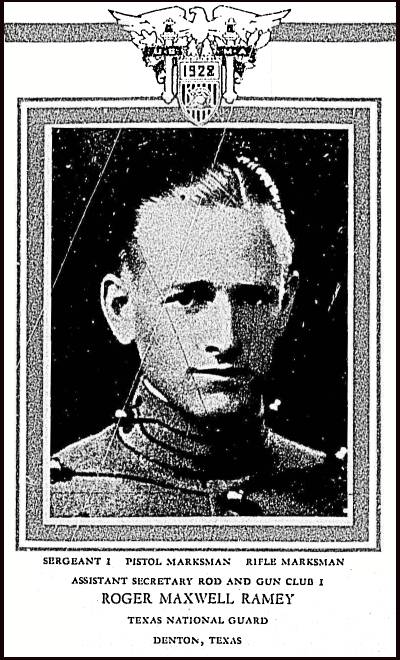
Roger
Maxwell Ramey's graduation photo from West Point, June
1928.
During
1928–29, Ramey received pilot training at the Air
Corps Primary Flying School at Brooks Field, TX and the
Advanced Flying School at Kelly Field, TX. He transferred
from the Calvary to the Air Corps on 21 November 1929,
and served for the next 5 years at Kelly and Brooks Fields,
and with the 1st Pursuit Group at Selfridge Field, Michigan.
From 1934-39, Ramey was an Instructor at Randolph Field,
TX; he was promoted to First Lieutenant in September 1938.
In
March 1939, he was transferred to Wheeler Field, HI to
serve as Intelligence Officer of the 18th Pursuit Group
(Interceptor). In June 1939, he was promoted to Captain
and, in July, became Commanding Officer of the 19th Pursuit
Squadron (Interceptor) at Wheeler Field. He was made Executive
Officer of 18th Pursuit Group (Interceptor) in April 1940,
also at Wheeler Field. Later that year, Ramey became Commanding
Officer of the 42d Bombardment Squadron (Medium) at Hickam
Field, HI and, in January 1941, was promoted to Major.
On 7 December 1941, Ramey was Operations Officer of the
18th Bomb Wing at Hickam Field (Pearl Harbor) during the
Japanese surprise attack. He was awarded a special commendation
for his attempts to save our aircraft while Japanese planes
strafed and bombed hangars, airplanes, and personnel.
Shortly after the Pearl Harbor attack, Ramey was promoted
to Lieutenant Colonel and made Plans and Training Officer
of 7th Bomber Command at Hickam. In March 1942, he was
promoted to Colonel and made Acting Deputy Chief of Staff
for Operations, Seventh Air Force, also at Hickam.
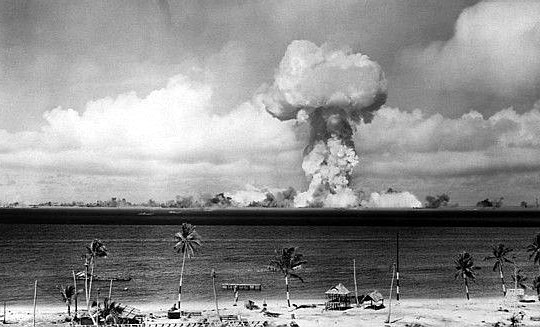
Able,
atomic bomb detonated in 1946 by the US Army Air Force
as part of Operation Crossroads.
On
July 1, 1946, General Ramey and Colonel William H. Blanchard,
commander of the 509th Bombardment Group (Very Heavy)
and Task Unit 1.5.1, flew aboard the B-29 ‘Dave's
Dream' piloted by Major Woodrow P. Swancutt for the ABLE
drop. The
23-kiloton bomb exploded 520 feet above a fleet of 94
test vessels arrayed in Bikini Atoll, but missed its intended
target
by over 1,800 feet. (The miss resulted in a government
investigation of the B-29 bomber's flight crew. Eventually,
it was determined that a flaw in the bomb's tail stabilizer
had caused the miss; the flight crew was not at fault.)
Although the atomic bomb inflicted heavy damage on elements
of the fleet, only five ships were sunk during
Test ABLE. U.S. Navy photo
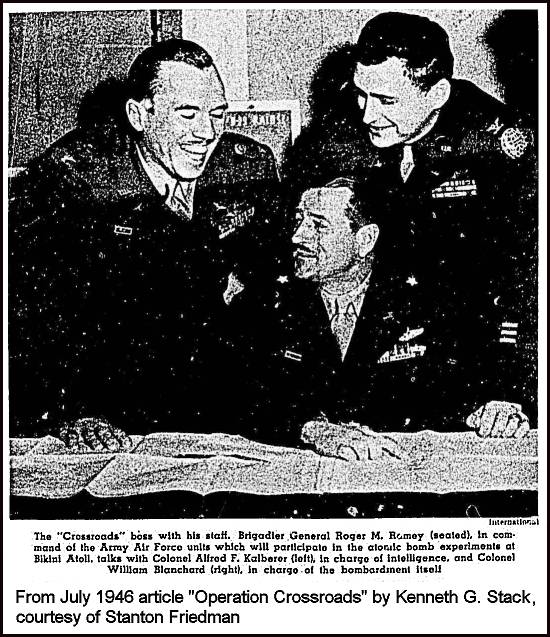
Photo
courtesy of www.roswellproof.com
Colonel
Ramey became Commanding Officer of the 43rd Bombardment
Group (Heavy) at Port Moresby, New Guinea in October 1942.
The bombing attacks of the 43rd repelled the Japanese
thrust at Port Moresby and brought about their expulsion
from Papua, New Guinea. In early 1943, he became Chief
of Staff of the 5th Bomber Command at Port Moresby and,
in the Battle of Bismarck Sea in March, Ramey directed
bombing attacks that resulted in a loss of 22 Japanese
ships. On 19 April 1943, he assumed command of the 5th
Bomber Command after its Commander, Brigadier General
Howard K. Ramey (no relation) was killed during a reconnaissance
mission. [Ramey AFB in Aguadilla, Puerto Rico was named
after Howard K. Ramey, not Roger M. Ramey.] Roger Ramey
was promoted to Brigadier General on 1 July 1943.
After
he took command, the 5th Bomber Command directed extensive
bombing operations in New Guinea, the Bismarck Archipelago,
and other sections of the Southwest Pacific. Ramey was
charged with planning and directing the bombing and strafing
attacks during the campaign which resulted in the capture
of Lae. General Ramey also conducted the devastating raids
which crushed the strong Japanese base at Wewak, and the
heavy accurate bombing of critical targets in the area
under land attack by Allied Forces. Ramey was awarded
the Army Distinguished Service Medal for these operations.
Ramey
was also awarded the Distinguished Service Cross (the
U.S. Army's second highest award for valor) for extraordinary
heroism while participating in an attack on the Japanese
base at Rabaul, New Britain. As command pilot leading
a flight against the base in his B-17 Heavy Bomber, (then)
Colonel Ramey remained at the attack scene for over two
hours, making 20 passes over the target, dropping flares
on each run, and thus drawing attention of searchlights
and diverting much of the anti-aircraft fire from other
bombers to his own.
During
December 1943-January 1944, Ramey returned to the U.S.
and took command of the 38th Flying Training Wing at Kirtland
Field, New Mexico. In May 1944, Ramey became Commander
of the 314th Bombardment Wing (Very Heavy) at Peterson
Field, Colorado. Shortly after that, he was made Chief
of Staff, 21st Bomber Command at Peterson Field. In November
1944, the 21st was moved to Guam and helped plan and direct
B-29 operations against mainland Japan from the Marianas.
Ramey
spent most of 1945 in the Pacific Theater of Operations.
In January, he replaced Major General Curtis LeMay as
Commander of the 20th Bomber Command and 58th Bombardment
Wing (Very Heavy) in the China-Burma-India Theater, based
in Kharagpur, India. In April, the 58th Bombardment Wing
moved to the Marianas Islands where it conducted raids
against Japan until the end of the war. During the Wing's
3600-mile move from India to the Marianas, not a single
airplane was lost. (After the war, Ramey was in charge
of Operation Sunset, which flew thousands of soldiers
home from the Pacific islands; again with a perfect safety
record.) In November, Ramey's 58th Bombardment Wing returned
to March Field in Riverside, CA.
In
1946, Ramey was assigned to temporary duty as Commander
of Task Group 1.5, the Army Air Forces unit responsible
for dropping the ABLE bomb (named Gilda and bearing the
likeness of Rita Hayworth, star of the 1946 movie 'Gilda')
during Operation Crossroads; the code name for the atomic
bomb tests at Bikini Atoll in the Marshall Islands. On
1 July 1946, Ramey and Colonel William H. Blanchard, commander
of the 509th Bombardment Group (Very Heavy) and Task Unit
1.5.1, flew aboard the B-29 ‘Dave's Dream' piloted
by Major Woodrow P. Swancutt for the ABLE drop. The 23-kiloton
bomb exploded 520 feet above a fleet of 94 test vessels
arrayed in Bikini Atoll, but missed its intended target
by over 1,800 feet. (The miss led to a government investigation
of the B-29 bomber's flight crew. Eventually, it was determined
that a flaw in the bomb's tail stabilizer had caused the
miss and the flight crew was not at fault.) Although the
atomic bomb inflicted heavy damage on elements of the
fleet, only five ships were sunk during Test ABLE. At
the conclusion of Operation Crossroads in August, Ramey
returned to the 58th Bombardment Wing which moved to Fort
Worth Army Air Field, TX, in September 1946.
The
Eighth Air Force was reactivated at Fort Worth Army Air
Field (renamed Carswell Air Force Base in January 1948)
on 1 November 1946 and Ramey's 58th Bombardment Wing was
merged into it. As a result, he was briefly made Chief
of Staff of the Eighth under Major General Clements McMullen.
Brig. Gen. Ramey assumed full command of the Eighth Air
Force in January 1947, when McMullen became Deputy Chief
of Staff of the Strategic Air Command.
The
Roswell New Mexico UFO Incident
On
the afternoon of 8 July 1947, 1st Lieutenant Walter Haut,
Public Information Officer at Roswell Army Air Field (RAAF)
in Roswell, New Mexico, issued a press release (on the
orders of RAAF Commander Colonel William Blanchard) stating
that personnel from the Field's 509th Bomb Group had recovered
a crashed "flying disc" from a ranch near Roswell,
sparking intense media interest. The following day, the
press reported that the Commander of the Eighth Air Force,
Brig. Gen. Roger M. Ramey, stated that, in fact, a radar-tracking
balloon had been recovered by RAAF personnel, not a "flying
disc." An ensuing press conference and photo session
featured debris allegedly recovered at Roswell that seemed
to confirm Ramey's weather balloon description. The explanation
satisfied the press, and as a result, this event was quickly
forgotten and almost completely ignored for more than
30 years.
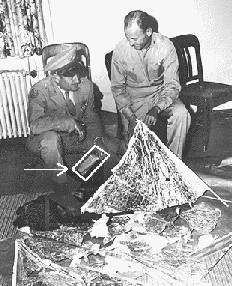
Brigadier
General Roger M. Ramey, Eighth Air Force Commander, and
Chief of Staff Colonel Thomas J. Dubose posed
with weather balloon in Fort Worth, Texas, July 8, 1947.
Ramey said this was the debris of what had been reported
as a
"flying disk" found near Roswell, New Mexico.
A controversial message held by Ramey is highlighted with
a box.
Photo courtesy of Frank Kleinwechte
However,
since the late 1970s, when important witnesses were first
found telling a different story, the incident has become
the subject of intense controversy.The U. S. military
upholds that what was actually recovered was debris from
an experimental high-altitude surveillance balloon belonging
to a classified program named "Mogul." But many
UFO proponents argue that a crashed alien craft and bodies
were recovered, and that the military engaged in a cover
up. The event ranks as one of the most publicized and
controversial alleged UFO incidents and has made the name
Roswell synonymous with UFOs. After his involvement in
1947, Ramey never publicly spoke of the Roswell incident
again.
Ramey
was nominated for promotion to Major General in the fall
of 1947; he was also awarded the Legion of Merit for his
role in Operation Crossroads. In 1948, the Eighth Air
Force began its conversion from the B-29 bomber to the
B-36 bomber. In January 1948, Ramey received his promotion
to Major General from President Truman. In the spring
of 1948 he repeated his role from 1946's Operation Crossroads
by directing Air Force units in Operation Sandstone, the
new A-bomb tests on Eniwetok Atoll. In June, he attended
his 20th anniversary class reunion at West Point. In August
1948, Ramey led a flight of 135 B-29 bombers in a massive
display of 700 planes over New York's new Idlewild Airport
(now JFK). In December 1949, Ramey was given the Fort
Worth Chamber of Commerce's "Man of the Year"
award for organizing rescue efforts during a disastrous
Fort Worth' flood earlier that year.
Ramey
was named Deputy Chief of Staff for Operations, Headquarters
U.S. Air Force, in 1950. A short time later, he became
Director of Operations and in announcing his appointment,
the Air Force Times described him this way. "...General
Ramey has a quick, incisive mind, the habit of getting
immediately at the nub of a problem and of expressing
decision in a few, simple words, embellished by a fabulous
sense of humor. Air officers who served with him in World
War II are still repeating with chuckles some of his classic,
always wise, but often unprintable comments on unit problems."
In
1951, Ramey took on additional duty as a member of the
Military Liaison Committee to the Atomic Energy Commission
in Washington, DC. In January 1953, he testified before
Congress regarding air accidents and Air Force plans for
more radar surveillance.
In
the spring of 1954, Ramey was awarded the third star of
a Lieutenant General and assumed command of the Fifth
Air Force under Far East Air Force, at Osan Air Base,
Korea (a few months later it moved to Nagoya, Japan).
Ramey was credited with rebuilding the Fifth Air Force
into a major unit, just as he had done with the Eighth
Air Force in Fort Worth. On 20 August 1955, Ramey was
decorated by South Korean President Syngman Rhee.
In
1956, Ramey was named Deputy Commander of the Continental
Air Defense Command and Vice Commander of the Air Defense
Command, at Ent AFB, CO. He eventually became Commander
of the Air Defense Command but, due to a heart attack
in September 1956, it was only for a short time. He retired
from the Air Force on 31 January 1957, due to his heart
problems.
After
his retirement, Ramey became Vice President of Commercial
Standard Insurance Company. In 1958, he was hired by Northrup
Aircraft as Corporate Vice President in charge of its
district offices in Washington, Dayton, Omaha, Ogden,
Huntsville, and Colorado Springs. In January 1958, he
was appointed by the Governor of Texas to the Board of
Regents of North Texas State College, his old alma mater
(now the University of North Texas). In September 1960,
he became president of Permanent Filter Company in Los
Angeles and retired from there in July 1962.
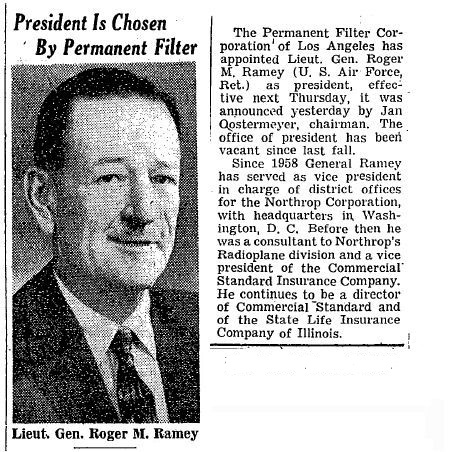
1960
photo courtesy of roswellproof.com
General
Roger Maxwell Ramey died on 4 March and his funeral was
held on Friday, 8 March 1963 at the First Methodist Church
in his hometown of Denton, Texas. He was survived by his
second wife, Eunice Latane ‘Worsham' Ramey, whom
he married in December 1950; and by their two children;
Kent, 11; and Mary Latane, 5.
Bio
compiled by Charles A. Lewis with gratitude to David Rudiak
for sharing his research materials.
Sources:
http://www.findagrave.com/cgi-bin/fg.cgi?page=gr&GRid=59658498
http://roswellproof.homestead.com/ramey_info.html
